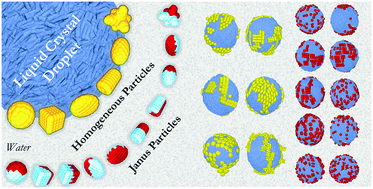当前位置:
X-MOL 学术
›
Mol. Syst. Des. Eng.
›
论文详情
Our official English website, www.x-mol.net, welcomes your feedback! (Note: you will need to create a separate account there.)
Nanoparticles shape-specific emergent behaviour on liquid crystal droplets
Molecular Systems Design & Engineering ( IF 3.6 ) Pub Date : 2019/12/09 , DOI: 10.1039/c9me00153k Zeynep Sumer 1, 2, 3, 4 , Alberto Striolo 1, 2, 3, 4
Molecular Systems Design & Engineering ( IF 3.6 ) Pub Date : 2019/12/09 , DOI: 10.1039/c9me00153k Zeynep Sumer 1, 2, 3, 4 , Alberto Striolo 1, 2, 3, 4
Affiliation

|
Self-assembly attracts enormous research attention because it is at the core of important applications ranging from medical treatments to renewable energy production. Among several classes of self-assembling materials, liquid crystals (LCs) and nanoparticles yield ordered structures under well-defined thermodynamic conditions and could yield supra-molecular aggregates, respectively. In this work, nanoparticle self-assembly on LC nano-droplets is investigated. The LC nano-droplets act as templating agents on which homogeneous and Janus nanoparticles of various geometrical features are adsorbed. LC mesogens and water have low mutual solubility, and under the conditions chosen the LCs yield bipolar nano-droplets. Particle self-assembly on oil nano-droplets is also considered for comparison. Our results reveal that the mesogens can direct the assembly of the nanoparticles. This effect is mainly governed by the nanoparticle size and shape. In some cases, strong evidence of emergent behaviour is observed depending on entropic forces that arise because of the shape and patchiness of the nanoparticles. For example, while one small spherical homogeneous particle does not show preferential adsorption on specific LC nano-droplet locations, 100 spherical nanoparticles preferentially agglomerate at the nano-droplet boojums, providing evidence of emergent behaviour. On the contrary, Janus spherical nanoparticles do not show such a strong emergent behaviour. Cylindrical NPs manifest the opposite trend: while homogeneous nano-cylinders do not exhibit orientational order on the LC nano-droplet, Janus ones either locate at the LC nano-droplet boojums or orient towards the direction vector of bipolar droplets. Quantification of the orientational order within the LC nano-droplets suggests that the self-assembly of the LC mesogens does not significantly change upon nanoparticle adsorption. These simulations clearly suggest an interplay between nanoparticle size, shape and chemical composition upon their self-assembly on LC nano-droplets. The results could be helpful for the design of new sensors and for the directed self-assembly of advanced materials.
中文翻译:

纳米粒子在液晶液滴上的形状特定的出射行为
自组装是从医学治疗到可再生能源生产等重要应用的核心,自组装引起了巨大的研究关注。在几类自组装材料中,液晶(LC)和纳米颗粒在明确定义的热力学条件下产生有序结构,并分别产生超分子聚集体。在这项工作中,研究了LC纳米液滴上的纳米粒子自组装。LC纳米微滴充当模板剂,各种几何特征的均质纳米颗粒和Janus纳米颗粒被吸附在其上。LC液晶元与水的互溶性较低,在所选条件下,LC会产生双极性纳米液滴。为了比较,还考虑了在油纳米滴上的颗粒自组装。我们的结果表明,液晶元可以指导纳米粒子的组装。该作用主要由纳米颗粒的大小和形状决定。在某些情况下,根据纳米粒子的形状和斑片所产生的熵力,观察到了强有力的证据来证明行为的出现。例如,虽然一个小的球形均质颗粒在特定的LC纳米液滴位置上没有显示出优先吸附,但是100个球形纳米颗粒在纳米液滴上聚集了优先团聚,从而提供了出现行为的证据。相反,Janus球形纳米颗粒没有表现出如此强烈的紧急行为。圆柱形NP呈现相反的趋势:虽然均相的纳米圆柱在LC纳米液滴上不显示取向顺序,Janus的分子要么位于LC纳米液滴boojums处,要么朝向双极液滴的方向矢量定向。LC纳米微滴内取向顺序的量化表明,LC介晶的自组装在纳米颗粒吸附后不会显着变化。这些模拟清楚地表明,纳米粒子的大小,形状和化学成分在LC纳米微滴上自组装后会相互影响。这些结果可能有助于设计新的传感器,并有助于先进材料的定向自组装。这些模拟清楚地表明,纳米粒子的大小,形状和化学成分在LC纳米微滴上自组装后会相互影响。该结果可能有助于新传感器的设计以及先进材料的定向自组装。这些模拟清楚地表明,纳米粒子的大小,形状和化学成分在LC纳米微滴上自组装后会相互影响。这些结果可能有助于设计新的传感器,并有助于先进材料的定向自组装。
更新日期:2020-02-24
中文翻译:

纳米粒子在液晶液滴上的形状特定的出射行为
自组装是从医学治疗到可再生能源生产等重要应用的核心,自组装引起了巨大的研究关注。在几类自组装材料中,液晶(LC)和纳米颗粒在明确定义的热力学条件下产生有序结构,并分别产生超分子聚集体。在这项工作中,研究了LC纳米液滴上的纳米粒子自组装。LC纳米微滴充当模板剂,各种几何特征的均质纳米颗粒和Janus纳米颗粒被吸附在其上。LC液晶元与水的互溶性较低,在所选条件下,LC会产生双极性纳米液滴。为了比较,还考虑了在油纳米滴上的颗粒自组装。我们的结果表明,液晶元可以指导纳米粒子的组装。该作用主要由纳米颗粒的大小和形状决定。在某些情况下,根据纳米粒子的形状和斑片所产生的熵力,观察到了强有力的证据来证明行为的出现。例如,虽然一个小的球形均质颗粒在特定的LC纳米液滴位置上没有显示出优先吸附,但是100个球形纳米颗粒在纳米液滴上聚集了优先团聚,从而提供了出现行为的证据。相反,Janus球形纳米颗粒没有表现出如此强烈的紧急行为。圆柱形NP呈现相反的趋势:虽然均相的纳米圆柱在LC纳米液滴上不显示取向顺序,Janus的分子要么位于LC纳米液滴boojums处,要么朝向双极液滴的方向矢量定向。LC纳米微滴内取向顺序的量化表明,LC介晶的自组装在纳米颗粒吸附后不会显着变化。这些模拟清楚地表明,纳米粒子的大小,形状和化学成分在LC纳米微滴上自组装后会相互影响。这些结果可能有助于设计新的传感器,并有助于先进材料的定向自组装。这些模拟清楚地表明,纳米粒子的大小,形状和化学成分在LC纳米微滴上自组装后会相互影响。该结果可能有助于新传感器的设计以及先进材料的定向自组装。这些模拟清楚地表明,纳米粒子的大小,形状和化学成分在LC纳米微滴上自组装后会相互影响。这些结果可能有助于设计新的传感器,并有助于先进材料的定向自组装。



























 京公网安备 11010802027423号
京公网安备 11010802027423号